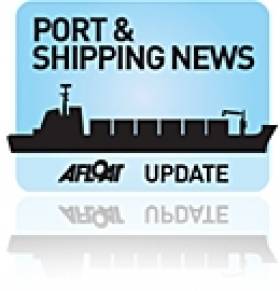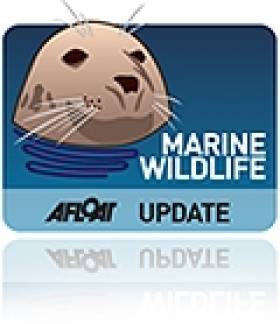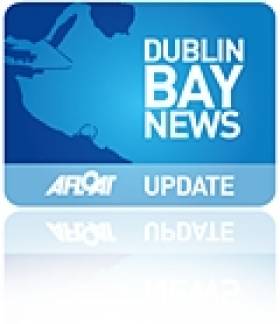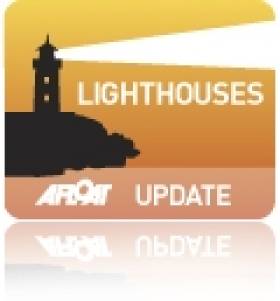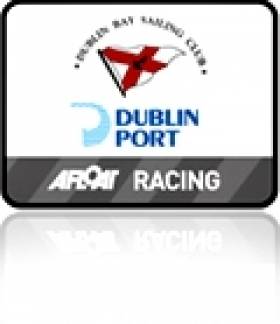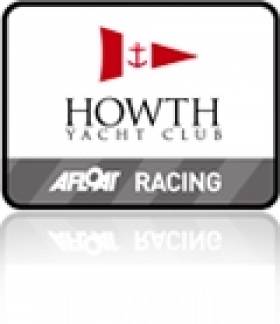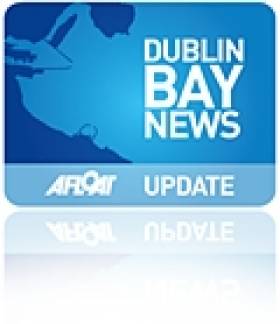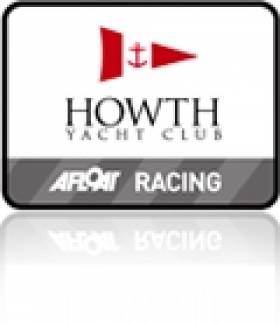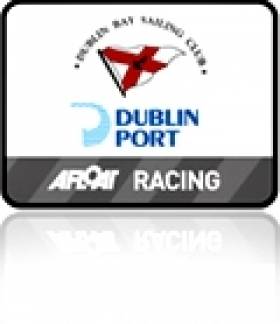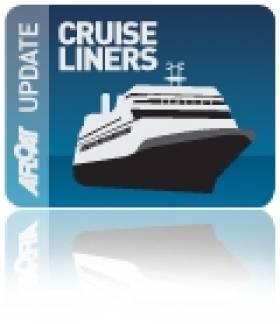Displaying items by tag: Dublin Bay
New Ship Tower Sails into Dublin
A revolutionary newbuild multi-purpose cargo vessel, E-Ship 1, docked at Dublin port for the first time today writes Jehan Ashmore. The vessel had arrived from Emden, Germany with a cargo of wind-turbines bound for a project in Leinster.
At both the fore and aft of the new vessel stands a pair of giant metal circular towers which gives the ship a highly distinctive profile. Each of the four rotor tower "sails" are 25 metres high and four metres wide and these towers are driven by electro-motors which together with the wind harness wind energy to provide thrust for the 12,810 gross tonnes vessel. The ship does retain a conventional engine plant below deck and a streamlined superstructure and sleek hull to
reduce drag.
With all these innovative features, E-Ship 1 derives its project name from the enviromental ethos of her owners, Enercon, one of the leading manufacturers of wind-turbine technolgy. The newbuild is also termed the "Turbo-Sail Freighter" which apart from using wind energy to cut down fuel costs and measures to reduce emissions, there is also a double hull to lessen pollution from oil pollution incidents.
The origins for the concept of the E-Ship 1 is not new. In 1852 the Magnus Effect was invented and is named after the works of German physicist, Heinrich Gustav Magnus. The Magnus effect is a force acting on a spinning body in a moving airstream, which acts perpendicularly to the direction of the airstream; in essence when applied to ships, propels the vessel forward.
Another, German, the engineer, Anton Flettner adapted the concept in 1925 with the first rotor vessel, Buckau, a former schooner that was refitted with rotors driven by an electric propulsion system. On several North Sea voyages, the rotors performed well, despite stormy seas, though the technology was not deemed successful enough as the conventional engines were still more efficient and with the low fuel costs remained cheaper to operate.
With the threat of global warming, times have changed dramatically and the need for the concept of the Flettner's rotor-sailing ship has come full-circle with the launch of E-Ship 1 in 2008. Using the latest technology developed for E-Ship 1, Enercon carried out extensive sea-trials last year and first sailed commercially this year.
E-Ship 1 was firstly built at the German shipbuilder Lindenau-Werft, but the yard was declared insolvency. This led to the newbuild to be towed in January 2009 to and completed by the Cassens Werft in Emden.
Enercon was founded in 1984 and has since installed over 16,000 wind turbines in over 30 countries. The specially designed ship will be able to continue transporting wind turbines and components worldwide in addition to heavy lift-cargoes, containers and dry cargoes. The E Ship 1 is due to depart Dublin on Wednesday.

(Below) The revolutionary rotor-sail, wind energy concept newbuild, E-Ship 1 at Dublin on 10 August and (Above) Stern-view of E-Ship 1 with aft-rotor sails and stern-ramp Photo Jehan Ashmore/ShipSNAPS
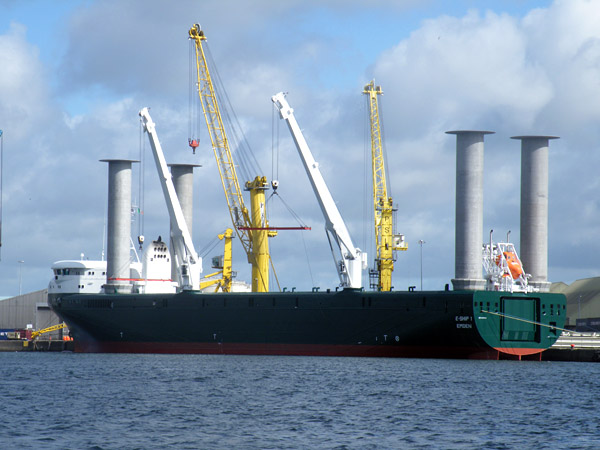
Should a bather step on a weever fish then the pain is excruciating as the spines embed into the human flesh and discharge their poison. (SEE RELATED VIDEO BELOW)
The pain is at its most intense for the first two hours when the foot normally goes red and swells up, and then it may feel numb until the following day with irritation and pain that may last for up to two weeks. Sometimes, the spine breaks off in the foot and it will cause discomfort until it is removed. You won't see a Weever fish easily but you will know it's there if you are unfortunate enough to stand on one since its back has a defensive sting mechanism. The sting can be very painful but will not cause permanent damage.
The poison is a type of protein and is heat labile. Most reports of stings occur during the month of August. This does not mean that this fish are particularly prevalent inshore during this month but merely reflects the greater numbers of bathers as the sea temperature reaches the highest of the year. The only death on record after someone being stung by a Weever occurred as long ago as 1927, when an angler suffered multiple stings whilst fishing off Dungeness in the UK.
The mouth itself is in an unusual position on its head, oblique and almost vertical and contains some of the most sharp and vicious looking teeth in the undersea world. Luckily it only reaches about 15 cm long.
The Weever has to be quick to catch is prey though, and for half a metre it has a fair turn of speed, before sinking to the sea floor. This fish does not have a swim bladder, the device used by most bony fish to keep buoyant.
The species found in shallow waters is called the Lesser Weever with the scientific name of Echiichthys vipera. There is a larger species called the Greater Weever, Trachinus draco, found in deeper water and occasionally seen on the fishmongers slab. The word 'weever' was first found used in the English language during the 17th century and comes from the Old northern French word 'wivre'.
One danger is that it can cause anaphylactic shock or allergic reaction and people have been known to die.
People who have been stung should take painkillers and if they develop an allergic reaction to the sting, a course of antihistamines is recommended
Seek assistance from a lifeguard who are all qualified first aiders.
Aspivenin syringes can painlessly draw out poison from the wound.
If you are away from a beach with lifeguard support, as soon as possible get the area which has been stung, invariably the foot, into hot water, this increases the blood flow which assists natural cleaning and healing, the heat also helps to breakdown the poison. The water needs to be over 40 degrees Celsius to be of any benefit in breaking down the poison.
Tankers Load Fuel in Dublin Bay
In a highly unusual procedure, a tanker took on bunkers (loading of fuel) while anchored in Dublin Bay. The procedure took place on 2 August when the Whitstar (2,159gt) moored alongside the larger Pembroke Fisher (9,356gt) writes Jehan Ashmore.
The Whitstar had arrived from Dover to conduct bunkering. The vessel approached the Pembroke Fisher to tie mooring ropes amidships, fore and aft.
The bunkering took several hours to complete. With bunkering complete, the Whitstar proceeded to the Clyde. Incidently, a fleetmate of Whitstar, the Whitchampion arrived at Dublin port earlier during the summer to load bunkers for a large cruiseship. While the re-fueled Pembroke Fisher returned to anchor overnight off Dalkey Island.
Prior to the bunkering operation, Pembroke Fisher had spent several days at anchorage south of Dalkey Island after discharging petroleum products at Dublin Port.
It is also unusual for commercial shipping to take anchorage off Dalkey Island while close to Killiney Bay. Otherwise, it is the norm for vessels to anchor in Dublin Bay with the majority of ships taking anchorage south-east off Dun Laoghaire.
The next day, Pembroke Fisher weighed anchor and firstly set a course for the Kish Lighthouse and then altered to proceed south down the Irish Sea bound for Milford Haven. The Welsh port is the location of one of the largest oil refineraries in the UK.

Whitstar moored alongside Pembroke Fisher on 2 August. The smaller tanker was transferring bunkers in a rare operation in Dublin Bay. Photo: Jehan Ashmore/ShipSNAPS
From Last Lightship to Last Lanby
The Commissioners of Irish Lights (CIL) withdrew the Codling Bank Lanby off Arklow on 24 July. This was the last Lanby to serve in Irish waters. The Lanby (Large Automated Navigation Buoy) is essentially a floating circular platform with a tower positioned centrally and fitted with a light to ward off potential dangers to shipping, writes Jehan Ashmore.
The Lanby was replaced with a Type 1 buoy which has a focal in excess of 5 metres and is fitted with a racon and Automatic Identification System (AIS).
Irish Lights aids to navigation tender, ILV Granuaile towed the former Codling Lanby to Dublin. The Lanby was hoisted out of the water and remains high and dry on the quayside awaiting demolition by the Hammond Lane Company. This final Lanby completes the withdrawal of Major Floating Aids to Navigation (MFAs) throughout Irish waters.
Lanbys were first introduced in the 1960s as replacements for lightships on certain stations. The ALF Gannet, the last Irish lightship, which was converted in the mid-1980's into an Automatic Light-Float (ALF) was withdrawn from the South Rock station off Portavogie in February 2009. The ALF Gannet was towed to Dun Laoghaire and laid-up at Carlisle Pier. Earlier this year ALF Gannet was sold and towed to new owners in the UK.
With modern navigating systems coupled with the amount of traffic and the degree of risk, CIL made the decision to withdraw the MFAs and replace them with Type 1 buoys.
The work of maintaining navigational aids is conducted at CIL's joint marine depot and head-quarters at Dun Laoghaire, which was built in 2008. A marine-depot facility did exist previously at the same site while administrative offices were located in Pembroke Street, Dublin.
In June, CIL celebrated its 200th year since establishment in 1810. The authority is entrusted to maintain, service and update all aids to navigation around the entire coastline of Ireland, providing a vital and invaluable service to mariners.
Assides the use of the tender, ILV Granuaile, Irish Lights also operate the tug-buoy tender, Puffin, also based at Dun Laoghaire.
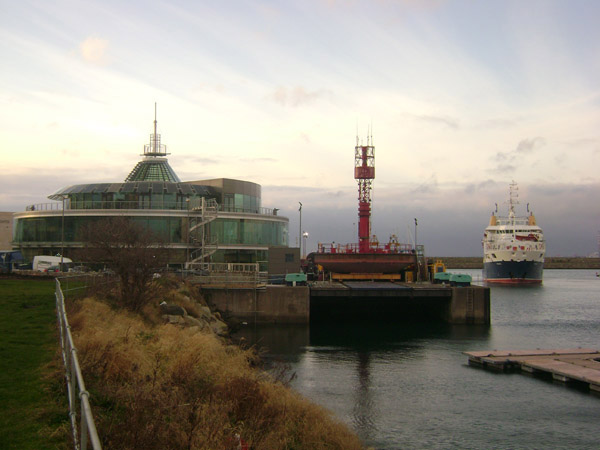
The Codling LANBY at Irish Lights headquarters, Dun Laoghaire in 2009 with tender ILV Granuaile. Photo: Jehan Ashmore/ShipSNAPS
Gung Ho Wins it in DBSC races
BENETEAU 31.7 - 1. Prospect (Chris Johnston), 2. Violet Flame (B.Murphy/L.Osbourne), 3. Thirty Something (Gerry Jones et al)
BENETEAU 31.7 Echo- 1. Violet Flame (B.Murphy/L.Osbourne), 2. Kernach (Eoin O'Driscoll), 3. Extremity (Paul D'Alton)
CRUISERS 0 Echo - 1. WOW (George Sisk), 2. Tsunami (Vincent Farrell)
CRUISERS 0 - 1. WOW (George Sisk), 2. Tsunami (Vincent Farrell)
CRUISERS 1 Echo - 1. Jetstream (Peter Redden), 2. Aztec 3 (Peter Beamish), 3. Something Else (J.Hall et al)
CRUISERS 1 - 1. Joker 11 (John Maybury), 2. Jetstream (Peter Redden), 3. Aztec 3 (Peter Beamish)
CRUISERS 2 Echo - 1. Bendemeer (Gerald Kinsella), 2. Cor Baby (Keith Kiernan et al), 3. Red Rhum (J Nicholson)
CRUISERS 2 - 1. Jawesome 11 (V.Kennedy/M.Dyke), 2. Bendemeer (Gerald Kinsella), 3. Red Rhum (J Nicholson)
CRUISERS 3 Echo - 1. Carrabeg (D.Martin/R.Deasy), 2. Saki (Paget McCormack et al), 3. Gung Ho (G & S O'Shea)
CRUISERS 3 - 1. Gung Ho (G & S O'Shea), 2. Asterix (J.Counihan/F.Meredith), 3. Supernova (K.Lawless et al)
CRUISERS 4 - 1. Rascal (K.Burke/S.Milner), 2. Maranda (Myles Kelly)
DRAGON Race 1- 1. Diva (R.Johnson/R.Goodbody), 2. Phantom (D.Williams/P.Bowring), 3. Susele (Michael Halpenny)
DRAGON Race 2- 1. Diva (R.Johnson/R.Goodbody), 2. Zinzan (Daniel O'Connor et al), 3. Phantom (D.Williams/P.Bowring)
DRAGON Race 3- 1. Diva (R.Johnson/R.Goodbody), 2. Zinzan (Daniel O'Connor et al), 3. Susele (Michael Halpenny)
FIREBALL Race 1- 1. Elevation (N.Colin/M.Casey), 2. Licence to Thrill (Louis Smyth)
FIREBALL Race 2- 1. Licence to Thrill (Louis Smyth), 2. Elevation (N.Colin/M.Casey)
FLYING FIFTEEN Race 1- 1. Kooigjug (K Dumpleton), 2. Hy5ive (D & S Gorman), 3. Gekko (S & P Nolan)
FLYING FIFTEEN Race 2- 1. Kooigjug (K Dumpleton), 2. Snow White (Frank Burgess), 3. Hy5ive (D & S Gorman)
GLEN - 1. Glenluce (D & R O'Connor), 2. Glenshesk (L.Faulkner et al), 3. Pterodactyl (R & D McCaffrey)
IDRA 14 FOOT Race 1- 1. Dunmoanin (Frank Hamilton), 2. Sapphire (Lorcan O'Sullivan), 3. Squalls (Stephen Harrison)
IDRA 14 FOOT Race 1- 1. Dunmoanin (Frank Hamilton), 2. Sapphire (Lorcan O'Sullivan)
RUFFIAN 23 - 1. Alias (D.Meeke/M.McCarthy), 2. Ruffles (Michael Cutliffe), 3. Ruff N Ready (Ann Kirwan et al)
SHIPMAN - 1. Jo Slim (J.Clarke et al), 2. Euphanzel lll (Louis McSherry et al), 3. Curraglas (John Masterson)
SIGMA 33 - 1. Rupert (R.Lovegrove/P.Varian), 2. White Mischief (Timothy Goodbody), 3. Gwili Two (D.Clarke/P.Maguire)
SQUIB Race 1- 1. Anemos (Pete & Ann Evans), 2. Femme Fatale (Joe O'Byrne), 3. Kookaburra (P & M Dee)
SQUIB Race 2- 1. Femme Fatale (Joe O'Byrne), 2. Nimble (Brian O'Hare), 3. Perfection (Jill Fleming)
WHITE SAIL CRUISERS Echo - 1. Finnegans Wake (T.Rowlands et al), 2. Coumeenole (Bill Kavanagh), 3. Calypso (Howard Knott)
WHITE SAIL CRUISERS - 1. Act Two (Michael O'Leary et al), 2. Calypso (Howard Knott), 3. Windshift (R O'Flynn et al)
Leila Leads Howth Yacht Club's 17 National Champs
HOWTH YACHT CLUB. 17 FOOTER CHAMPS 07/08/2010 17 Footer SCRATCH: 1, Leila R Cooper (12.00); 2, Rita Lynch/Curley (14.00); 3, Isobel B & C Turvey (14.00); 4, Pauline O'Doherty/Ryan (15.00); 5, Aura I Malcolm (16.00); 17 Footer ECHO: 1, Pauline O'Doherty/Ryan (11.00); 2, Isobel B & C Turvey (12.50); 3, Leila R Cooper (14.50); 4, Aura I Malcolm (17.00); 5, Echo B & H Lynch (17.00)
A ship's pass dated 1687, signed by King James II and Samuel Pepys, which was acquired by the Dublin Port & Docks board in 1924, was presented to the National Library of Ireland today by Enda Connellan, CEO, Dublin Port Company who noted that "Dublin Port Company is delighted to present this interesting and rare historical document to the National Library of Ireland. This will ensure that it is appropriately conserved and displayed. In its new home it will also be more accessible to the public."
The pass is one of the few known examples of 17th century ships' passes in the world, with others held at the National Archives in Kew, London and at the National Maritime Museum in Greenwich.
The example presented to the National Library of Ireland was designed to provide passage for the merchant vessel the Mary of Cork, free from interference by English warships or warships belonging to states maintaining diplomatic relations with England.
The vessel left Dublin port in late 1687, bound for the Canary Islands. At the time, the Canary Islands were major exporters of sugar and Malvasia, a fortified white wine which travelled well and was extremely popular in Britain. The Mary of Cork may have been trading in such foodstuffs, in return for products such as salted Irish beef.
The vessel was manned by a crew of five and captained by Zachary Peebuchet.
The Mary of Cork ship's pass was issued at the Court of Whitehall on 29 September 1687 and was signed by King James II (Lord High Admiral 1685-1688) and Samuel Pepys (in his capacity as Secretary to the Admiralty). On 18 April 1688, the ship's pass was returned to Ireland, where it was entered into the registry of the High Court of Admiralty of Ireland by Thomas Williamson. It was acquired by the Dublin Port & Docks Board in 1924, and will soon be on display in the National Library's Department of Manuscripts.
Vintage Howth 17 Champs Get Underway This Evening
The Howth 17 National Championships takes place at Howth Yacht Club tomorrow. Racing commences this evening (Friday) at 7pm with a course selected from the East Pier race card and then on Saturday there will be a Windward / Leeward courses set.
Shannagh Wins Dublin Bay Ruffian Race
BENETEAU 31.7 Echo- 1. Kernach (Eoin O'Driscoll), 2. Levana (Jean Mitton), 3. Fiddly Bits (Kevin Byrne et al)
BENETEAU 31.7 - 1. Levana (Jean Mitton), 2. Prospect (Chris Johnston), 3. Levante (B.Leyden/M.Leahy)
CRUISERS 0 Echo - 1. Tsunami (Vincent Farrell), 2. Tiamat (Tim Costello), 3. Lively Lady (Derek Martin)
CRUISERS 0 - 1. WOW (George Sisk), 2. Tiamat (Tim Costello), 3. Tsunami (Vincent Farrell)
CRUISERS 1 Echo - 1. Team Windmill (Andrew Sarratt), 2. Joker 11 (John Maybury), 3. Jetstream (Peter Redden)
CRUISERS 1 - 1. Team Windmill (Andrew Sarratt), 2. Joker 11 (John Maybury), 3. Jalapeno (Dermod Baker et al)
CRUISERS 2 Echo - 1. Red Rhum (J Nicholson), 2. Bendemeer (Gerald Kinsella), 3. Dick Dastardly (B.Cusack et al)
CRUISERS 2 - 1. Red Rhum (J Nicholson), 2. Dick Dastardly (B.Cusack et al), 3. Jawesome 11 (V.Kennedy/M.Dyke)
CRUISERS 3 - 1. Supernova (K.Lawless et al), 2. Cries of Passion (Bryan Maguire), 3. Two Step (Ross Doyle)
CRUISERS 3 Echo - 1. Syzrgy (Rowan Fogarty), 2. Papytoo (M.Walsh/F.Guilfoyle), 3. Hyflyer (John Barnard)
DRAGON - 1. Susele (Michael Halpenny), 2. Phantom (D.Williams/P.Bowring), 3. Zu (P.Dee et al)
FLYING FIFTEEN - 1. Flyer (Niall Coleman), 2. Kooigjug (K Dumpleton), 3. Fifty Somethings (David Mulvin)
GLEN - 1. Pterodactyl (R & D McCaffrey), 2. Glencree (J.Bligh/H.Roche), 3. Glenmarissa (F.Elmes/W.Higgins)
RUFFIAN 23 - 1. Shannagh (S.Gill/P.MacDiarmada), 2. Ruffles (Michael Cutliffe), 3. Ruff Nuff (D & C Mitchell)
SB3s - 1. Design Security (Colin Galavan), 2. Flutter (Andrew Algeo), 3. Alert Packaging (Justin Burke)
SHIPMAN - 1. Whiterock (Henry Robinson), 2. Curraglas (John Masterson), 3. Viking (Brian Glynn et al)
SIGMA 33 - 1. White Mischief (Timothy Goodbody), 2. Rupert (R.Lovegrove/P.Varian), 3. Popje (Ted McCourt)
SQUIB - 1. Anemos (Pete & Ann Evans), 2. Kookaburra (P & M Dee), 3. Ladybird (M.Muldoon/B.Stevens)
WHITE SAIL CRUISERS Echo - 1. Coumeenole (Bill Kavanagh), 2. Arwen (Philip O'Dwyer), 3. Calypso (Howard Knott)
WHITE SAIL CRUISERS - 1. Arwen (Philip O'Dwyer), 2. Calypso (Howard Knott), 3. Act Two (Michael O'Leary et al)
'The World' Arrives on Dublin Bay! Pics Here!
The World, a 644 foot ship, owned by its residents arrived at the Poolbeg lighthouse on Dublin bay yesterday afternoon (Wednesday, August 4 2010) for a four day stop over in Dublin. The residents, from about 40 different countries, live on board as it slowly circumnavigates the globe. Arrival photos below:






























